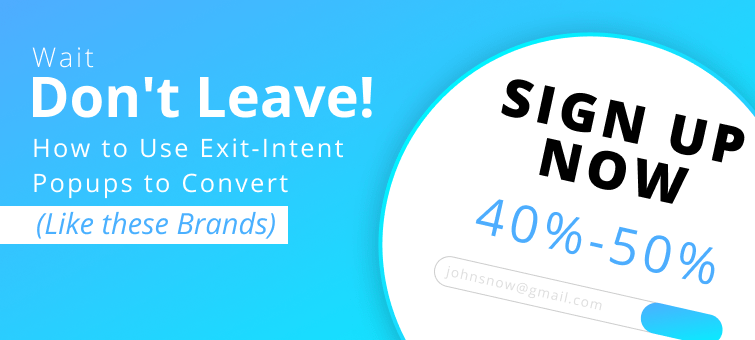Once upon a time, we lived in a world where website masters bombarded their visitors with annoying popup ads.
It ruined the online experience and forced millions to integrate ad blockers into their browsers. Fast forward to today, and you have brands using more innovative marketing tactics that cater to their target audience. Out went the excessive popups and in came more strategic popup ads.
However, there are some brands still struggling with these methods.
In the US, 18% of desktop and mobile users use ad blockers. While this number isn’t staggering, it does show that there are still some issues with sites dealing with pesky popups.
So why should marketers use them if their visitors don’t want them? The simple answer – is it’s not about the medium; it’s the delivery.
This is why some e-commerce brands see a 35% decrease in lost visitors just by implementing exit-intent popups. That says a lot when 72.8% of visitors abandon their shopping carts, and another 60% bounce away from your site.
How else will you get their attention before they click the “X” on your tab? If you can craft the ideal popup for visitors who are about to click away, you can capture 10-35% of those leads.
What sets these apart from typical popups is that they only appear when the user shows the intent to exit (hence their name).
These are cleverly made and only work for the most qualified visitors. This, in turn, means more conversions for you.
There’s no one-size-fits-all method, so you’ll have to judge better to determine which popups will work for your target customer.
Let’s look at how several brands successfully use exit-intent popups.
Belk: Targeting the Savvy Shopper
Who doesn’t like saving money? Any chance online shoppers get to save money with their favorite brands, they’re on it.
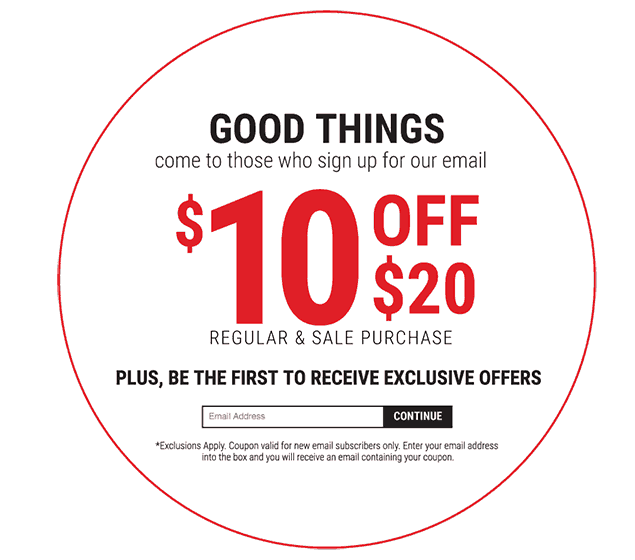
And that’s what makes this exit intent popup from Belk successful. You’ll find this commonly used throughout the e-commerce industry.
It asks for the visitor’s email address in exchange for not one but two coupons – one for $10 and the other for $20 off. Then they put in big bold letters that the visitor will receive free exclusive offers via email.
This is something that you can quickly implement into your strategy. Play around with different coupon offers to see what converts the best.
Skullcandy: Waging Psychological Warfare
Hacking the shoppers’ instinct to buy at bargain prices is one way to wage psychological warfare. But there’s another, yet clever way to do it.
Take a look at this ad from Skullcandy.
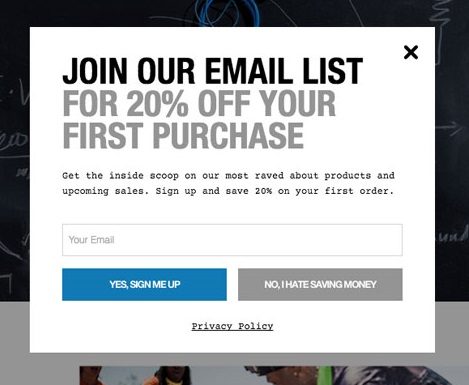
It has a 20% off offer for your first purchase, which is compelling. But the kicker (and it’s quite effective) is the “Yes” or “No” option.
You can select “Yes, sign me up” or “No, I hate saving money.” What makes the negative call to action (CTA) a clever tactic is that a lot of people don’t like to lose, miss out, or admit something they’re not so proud to admit.
And if you’ve been around the web lately, you’ll find some pretty outlandish negative CTA. Make sure yours is encouraging, not off-putting.
BeHappy: Cutting Down Abandoned Cart Rate
We’ve already mentioned the astonishing rate of abandoned carts witnessed by e-commerce shops. But what can you do to change the tide?
Here’s what BeHappy and many other brands are doing to target shoppers that try to exit before checking out.
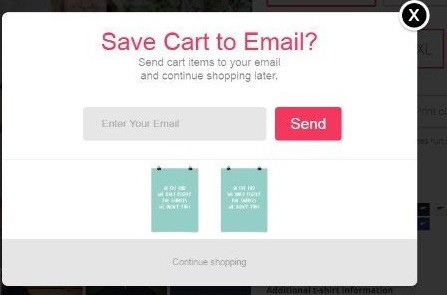
When asked at the appropriate time, a simple question can go very far: “Save cart to email?”
For instance, say you have a visitor using her tablet to shop for items in your store. She’s on the road and gets a message on social media that’ll eventually distract her from returning to your store.
So you use an exit intent popup to offer her a great solution – to save all that shopping she’s done and have it conveniently sent to her inbox. Then maybe when she gets home, she’ll continue to check out on her desktop.
Century 21: Using the Word “Free”
You won’t find many brands that offer free shipping for orders under $50. But Century 21 did just that and had a great campaign.
Irresistible offers, such as freebies, tend to work well for online retailers. Take a look at this exit popup to see it doesn’t take clever words or flashy designs to convert:
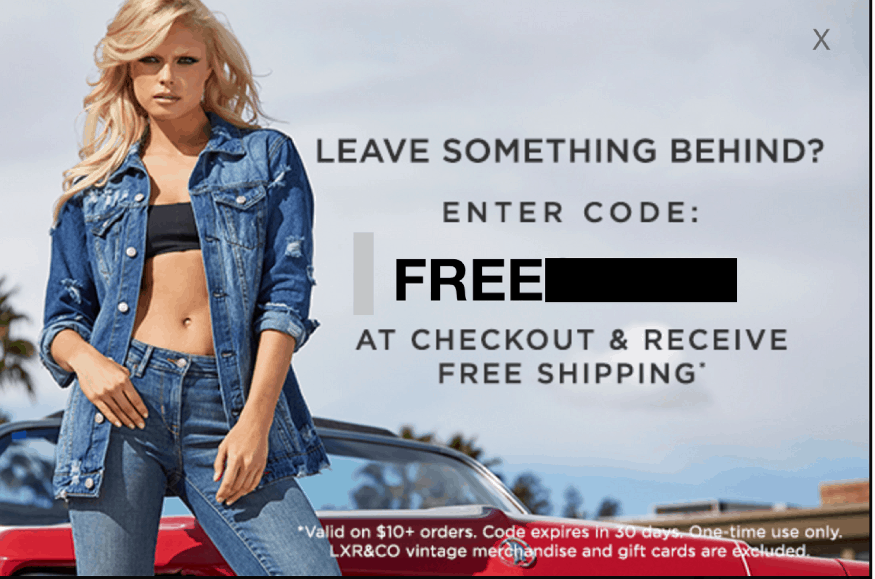
There are several reasons why this popup ad works. For one, it’s using the word free, which is big and bold. Then the free shipping offer is for orders as low as $10 (captures both big spenders and light shoppers).
And last, it puts a 30-day expiration date on it, which gives shoppers enough time to shop and still get the deal. But since it’s only for one-time use, shoppers will be inclined to buy as much as possible.
In return, this campaign received an 8.4% conversion rate. That’s 664 people converting out of the 11,818 visitors that saw it. Not bad!
So What Can You Do to Increase Your Conversions?
As you can see from these four examples, there are various ways and moments to use these popups to capture qualified leads. The key is to keep your customer personas and buyer’s journey in mind.
Here are some ideas to target visitors with the right message at the right time.
Create a Strong Sense of Urgency
There are several ways you can create a sense of urgency in your visitors. The two most popular tactics include implying scarcity or offering a limited-time deal.
Let’s say you have a visitor who shows interest in several products and explores several pages on your site. You can trigger an exit-intent popup to appear once they try to leave that says something like:
“30% Off Your Next Order!” Then have a visual timer counting down from 1 hour. Here’s a great example:
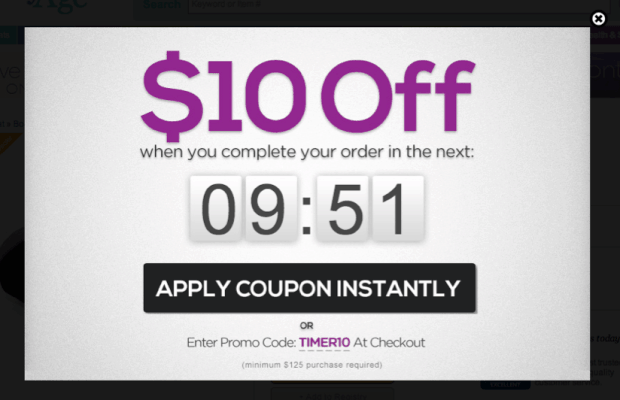
The discount, timer, and purchase buttons are the most noticeable on the popup. The viewer will quickly understand the offer and the countdown ticker will create a healthy sense of anxiety to act quickly.
However, if you want to target reactions using scarcity, you can do something like this:

As your visitor is about to leave, a popup distracts them. They see one of the items they viewed is almost sold out and may decide to buy immediately. It sure beats shopping around and missing out on a potentially great deal.
Offer Your Visitors Choices
If there’s anything online shoppers like, it’s a choice. So in your popup ad, why not give them several options?
For example, if you’re asking them to sign up for your free newsletter, then have them select their interests. This way, they’re only receiving content they want to read. And this will also help boost your email open rates.
Try asking your visitors what they want deals on women’s clothes, kids’ clothes, shoes, and so on. This way, you can segment your campaigns in a hyper-targeted manner.
Just make sure you don’t have too many options. A good 3-5 should suffice. Remember that they’re receiving separate emails for each interest, and you don’t want them bombarded with emails.
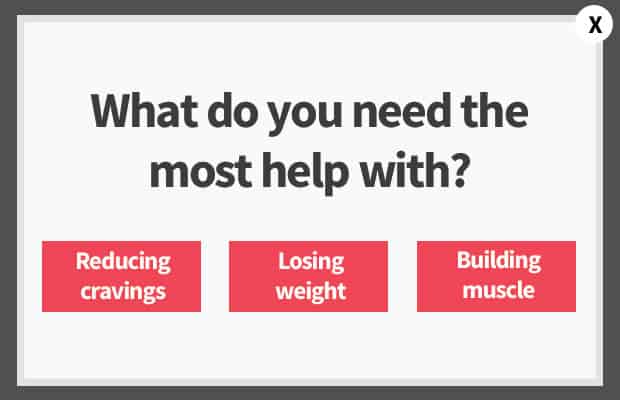
When you give your visitors options, it makes them take your offer into deeper consideration. Giving them just a yes or no option may trigger them to decline your offer too quickly.
Crafting Exit-Intent Popups that Convert
Okay, you’re all for using exit-intent popups to convert – but how do you create them? It takes a mix of design and coding skills to set them up (which you may lack) properly.
Or at least so you thought. This is where services like Poptin come in. This platform is simple-to-use for beginners – just choose your color, layout, and design. Then you drag and drop it into your site.
It’s compatible with any website, allowing you to get up and running quickly. If you’re ready to start your exit-intent popups, start making Poptins today!
